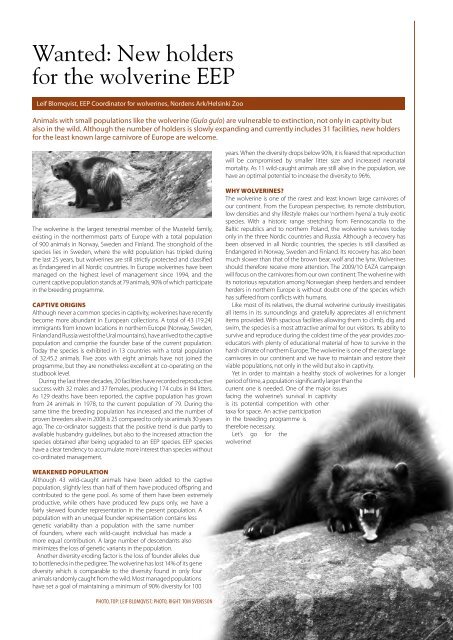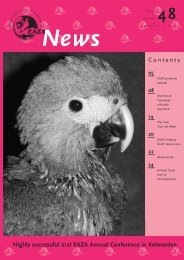EAZA NEWS 65 - European Association of Zoos and Aquaria
EAZA NEWS 65 - European Association of Zoos and Aquaria
EAZA NEWS 65 - European Association of Zoos and Aquaria
You also want an ePaper? Increase the reach of your titles
YUMPU automatically turns print PDFs into web optimized ePapers that Google loves.
Wanted: New holders<br />
for the wolverine EEP<br />
Leif Blomqvist, EEP Coordinator for wolverines, Nordens Ark/Helsinki Zoo<br />
Animals with small populations like the wolverine (Gulo gulo) are vulnerable to extinction, not only in captivity but<br />
also in the wild. Although the number <strong>of</strong> holders is slowly exp<strong>and</strong>ing <strong>and</strong> currently includes 31 facilities, new holders<br />
for the least known large carnivore <strong>of</strong> Europe are welcome.<br />
The wolverine is the largest terrestrial member <strong>of</strong> the Mustelid family,<br />
existing in the northernmost parts <strong>of</strong> Europe with a total population<br />
<strong>of</strong> 900 animals in Norway, Sweden <strong>and</strong> Finl<strong>and</strong>. The stronghold <strong>of</strong> the<br />
species lies in Sweden, where the wild population has tripled during<br />
the last 25 years, but wolverines are still strictly protected <strong>and</strong> classified<br />
as Endangered in all Nordic countries. In Europe wolverines have been<br />
managed on the highest level <strong>of</strong> management since 1994, <strong>and</strong> the<br />
current captive population st<strong>and</strong>s at 79 animals, 90% <strong>of</strong> which participate<br />
in the breeding programme.<br />
Captive origins<br />
Although never a common species in captivity, wolverines have recently<br />
become more abundant in <strong>European</strong> collections. A total <strong>of</strong> 43 (19.24)<br />
immigrants from known locations in northern Europe (Norway, Sweden,<br />
Finl<strong>and</strong> <strong>and</strong> Russia west <strong>of</strong> the Ural mountains), have arrived to the captive<br />
population <strong>and</strong> comprise the founder base <strong>of</strong> the current population.<br />
Today the species is exhibited in 13 countries with a total population<br />
<strong>of</strong> 32.45.2 animals. Five zoos with eight animals have not joined the<br />
programme, but they are nonetheless excellent at co-operating on the<br />
studbook level.<br />
During the last three decades, 20 facilities have recorded reproductive<br />
success with 32 males <strong>and</strong> 37 females, producing 174 cubs in 84 litters.<br />
As 129 deaths have been reported, the captive population has grown<br />
from 24 animals in 1978, to the current population <strong>of</strong> 79. During the<br />
same time the breeding population has increased <strong>and</strong> the number <strong>of</strong><br />
proven breeders alive in 2008 is 25 compared to only six animals 30 years<br />
ago. The co-ordinator suggests that the positive trend is due partly to<br />
available husb<strong>and</strong>ry guidelines, but also to the increased attraction the<br />
species obtained after being upgraded to an EEP species. EEP species<br />
have a clear tendency to accumulate more interest than species without<br />
co-ordinated management.<br />
Weakened population<br />
Although 43 wild-caught animals have been added to the captive<br />
population, slightly less than half <strong>of</strong> them have produced <strong>of</strong>fspring <strong>and</strong><br />
contributed to the gene pool. As some <strong>of</strong> them have been extremely<br />
productive, while others have produced few pups only, we have a<br />
fairly skewed founder representation in the present population. A<br />
population with an unequal founder representation contains less<br />
genetic variability than a population with the same number<br />
<strong>of</strong> founders, where each wild-caught individual has made a<br />
more equal contribution. A large number <strong>of</strong> descendants also<br />
minimizes the loss <strong>of</strong> genetic variants in the population.<br />
Another diversity eroding factor is the loss <strong>of</strong> founder alleles due<br />
to bottlenecks in the pedigree. The wolverine has lost 14% <strong>of</strong> its gene<br />
diversity which is comparable to the diversity found in only four<br />
animals r<strong>and</strong>omly caught from the wild. Most managed populations<br />
have set a goal <strong>of</strong> maintaining a minimum <strong>of</strong> 90% diversity for 100<br />
Photo, toP: Leif BLomqvist; Photo, right: tom svensson<br />
years. When the diversity drops below 90%, it is feared that reproduction<br />
will be compromised by smaller litter size <strong>and</strong> increased neonatal<br />
mortality. As 11 wild-caught animals are still alive in the population, we<br />
have an optimal potential to increase the diversity to 96%.<br />
Why Wolverines?<br />
The wolverine is one <strong>of</strong> the rarest <strong>and</strong> least known large carnivores <strong>of</strong><br />
our continent. From the <strong>European</strong> perspective, its remote distribution,<br />
low densities <strong>and</strong> shy lifestyle makes our ‘northern hyena’ a truly exotic<br />
species. With a historic range stretching from Fennosc<strong>and</strong>ia to the<br />
Baltic republics <strong>and</strong> to northern Pol<strong>and</strong>, the wolverine survives today<br />
only in the three Nordic countries <strong>and</strong> Russia. Although a recovery has<br />
been observed in all Nordic countries, the species is still classified as<br />
Endangered in Norway, Sweden <strong>and</strong> Finl<strong>and</strong>. Its recovery has also been<br />
much slower than that <strong>of</strong> the brown bear, wolf <strong>and</strong> the lynx. Wolverines<br />
should therefore receive more attention. The 2009/10 <strong>EAZA</strong> campaign<br />
will focus on the carnivores from our own continent. The wolverine with<br />
its notorious reputation among Norwegian sheep herders <strong>and</strong> reindeer<br />
herders in northern Europe is without doubt one <strong>of</strong> the species which<br />
has suffered from conflicts with humans.<br />
Like most <strong>of</strong> its relatives, the diurnal wolverine curiously investigates<br />
all items in its surroundings <strong>and</strong> gratefully appreciates all enrichment<br />
items provided. With spacious facilities allowing them to climb, dig <strong>and</strong><br />
swim, the species is a most attractive animal for our visitors. Its ability to<br />
survive <strong>and</strong> reproduce during the coldest time <strong>of</strong> the year provides zooeducators<br />
with plenty <strong>of</strong> educational material <strong>of</strong> how to survive in the<br />
harsh climate <strong>of</strong> northern Europe. The wolverine is one <strong>of</strong> the rarest large<br />
carnivores in our continent <strong>and</strong> we have to maintain <strong>and</strong> restore their<br />
viable populations, not only in the wild but also in captivity.<br />
Yet in order to maintain a healthy stock <strong>of</strong> wolverines for a longer<br />
period <strong>of</strong> time, a population significantly larger than the<br />
current one is needed. One <strong>of</strong> the major issues<br />
facing the wolverine’s survival in captivity<br />
is its potential competition with other<br />
taxa for space. An active participation<br />
in the breeding programme is<br />
therefore necessary.<br />
Let’s go for the<br />
wolverine!

















